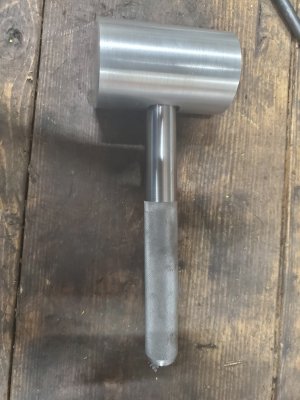- Joined
- Feb 2, 2020
- Messages
- 149
I have seen several homemade hammers lately and thought I should try to make one. I really wanted to make a brass hammer but I need to order some brass first. I had some aluminum laying around plus enough steel for a handle. Figured it would be best if I failed to fail with metal I had laying around.
Used my lathe to make the handle and made the end of of 5/8 and 3/4 then made a taper to blend it into the handle. Took some 2" aluminum and turned it down just enough so I could polish it up. Took the chunk of aluminum to the mill and drilled a 5/8 hole and then a 3/4 so the handle fits in snug.
Added loctite to the handle then tapped it into place. The hammer is bigger and heavier than I planned but I still like it. Right when I was walking out of the shop I happened to notice a 1-1/4" piece of aluminum that would have be a better alternative but that's how it goes.
Hammer head is almost 2" wide and 3.25" long. I didn't measure when I cut the hammer. I just went by what looked right. The handle is about 6" long or so.
Used my lathe to make the handle and made the end of of 5/8 and 3/4 then made a taper to blend it into the handle. Took some 2" aluminum and turned it down just enough so I could polish it up. Took the chunk of aluminum to the mill and drilled a 5/8 hole and then a 3/4 so the handle fits in snug.
Added loctite to the handle then tapped it into place. The hammer is bigger and heavier than I planned but I still like it. Right when I was walking out of the shop I happened to notice a 1-1/4" piece of aluminum that would have be a better alternative but that's how it goes.
Hammer head is almost 2" wide and 3.25" long. I didn't measure when I cut the hammer. I just went by what looked right. The handle is about 6" long or so.






